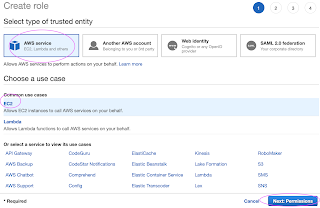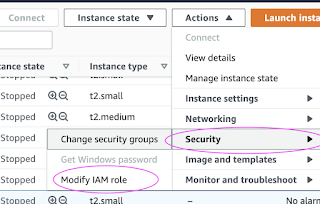What is Amazon EKS
Amazon EKS is a fully managed container orchestration service. EKS allows you to quickly deploy a production ready Kubernetes cluster in AWS, deploy and manage containerized applications more easily with a fully managed Kubernetes service.
EKS takes care of master node/control plane. We need to create worker nodes.
Please watch steps in YouTube channel:
Pre-requisites:
This Lab is using Jenkins EC2 instance. Jenkins EC2 instance needs to have following configured:
Install AWS CLI – Command line tools for working with AWS services, including Amazon EKS.
Install eksctl – A command line tool for working with EKS clusters that automates many individual tasks.
Install kubectl – A command line tool for working with Kubernetes clusters.
Create IAM Role with Administrator Access

Now search for
Skip on create tag.
Now give a role name and create it.
Go to AWS console, click on EC2, select EC2 instance, Choose Security.
Click on Modify IAM Role

Choose the role you have created from the dropdown.
Select the role and click on Apply.

the above command should create a EKS cluster in AWS, it might take 15 to 20 mins. The eksctl tool uses CloudFormation under the hood, creating one stack for the EKS master control plane and another stack for the worker nodes.
eksctl get cluster --name demo-eks --region us-east-1
This should confirm that EKS cluster is up and running.
Update Kube config by entering below command:
aws eks update-kubeconfig --name demo-eks --region us-east-1
kubeconfig file be updated under /var/lib/jenkins/.kube folder.
you can view the kubeconfig file by entering the below command:
cat /var/lib/jenkins/.kube/config
Connect to EKS cluster using kubectl commands
To view the list of worker nodes as part of EKS cluster.
kubectl get nodes
kubectl get ns
Deploy Nginx on a Kubernetes Cluster
Let us run some apps to make sure they are deployed to Kubernetes cluster. The below command will create deployment:
kubectl create deployment nginx --image=nginx
View Deployments
kubectl get deployments
Delete EKS Cluster using eksctl
eksctl delete cluster --name demo-eks --region us-east-1
the above command should delete the EKS cluster in AWS, it might take a few mins to clean up the cluster.
Errors during Cluster creationeksctl delete cluster --name demo-eks --region us-east-1












Thank you for giving a excellent explaination on ci CD pipeline example
ReplyDeleteNo Words Sir, Really great.
ReplyDeleteThe Spectrum is built on the idea that teaching behaviour is a chain of decision-making and that every deliberate act of teaching is a result of a previous decision.Modern spirituality Singapore
ReplyDelete